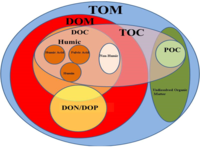
Photo from wikipedia
Simple Summary We used a 1000 km long latitudinal gradient in north-western Russia to study the potential impacts of a changing climate on soil invertebrates visible by a naked eye… Click to show full abstract
Simple Summary We used a 1000 km long latitudinal gradient in north-western Russia to study the potential impacts of a changing climate on soil invertebrates visible by a naked eye (insects, spiders, earthworms etc.). We extracted these animals from soil, weighed them and identified them to the species level. We found that the diversity of soil invertebrates decreased towards the north, whereas the latitudinal pattern in biomass depended on the animal’s feeding habit. The biomass of species feeding on live plant roots and fungal mycelia decreased towards the north, whereas the biomass of species feeding on dead plant tissues and live invertebrates showed no significant latitudinal changes. The discovery of this variation in latitudinal biomass patterns suggests that soil invertebrates from different feeding guilds may respond differently to climate change. As a result, the biomass ratio between consumers and their food resources (e.g., herbivores and plants, predators and prey) may change. We poorly understood how this change will affect the future structure and functions of boreal forest ecosystems. Abstract Latitudinal gradients allow insights into the factors that shape ecosystem structure and delimit ecosystem processes, particularly climate. We asked whether the biomass and diversity of soil macrofauna in boreal forests change systematically along a latitudinal gradient spanning from 60° N to 69° N. Invertebrates (3697 individuals) were extracted from 400 soil samples (20 × 20 cm, 30 cm depth) collected at ten sites in 2015–2016 and then weighed and identified. We discovered 265 species living in soil and on the soil surface; their average density was 0.486 g d·w·m−2. The species-level diversity decreased from low to high latitudes. The biomass of soil macrofauna showed no latitudinal changes in early summer but decreased towards the north in late summer. This variation among study sites was associated with the decrease in mean annual temperature by ca 5 °C and with variation in fine root biomass. The biomass of herbivores and fungivores decreased towards the north, whereas the biomass of detritivores and predators showed no significant latitudinal changes. This variation in latitudinal biomass patterns among the soil macrofauna feeding guilds suggests that these guilds may respond differently to climate change, with poorly understood consequences for ecosystem structure and functions.
Journal Title: Insects
Year Published: 2022
Link to full text (if available)
Share on Social Media: Sign Up to like & get
recommendations!